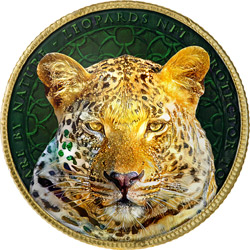One of the many features of being a Londolozi Live member is the opportunity to tell us which of the Leopards of Londolozi you’ve encountered during your visit! Once you’ve done this the leopard cards will move to your profile page collection – a wonderful reminder of your stay with us.
We don't know much about this leopard.
Born to the Tugwaan female in August 1992, this leopard would redefine the relationship between man and wild cat.
Unofficially the biggest leopard in the Sabi Sands, the Anderson male is an absolutely enormous individual in north western Londolozi.
The King of Londolozi in his day; an enormous male whose offspring still inhabit the reserve.
The Campbell Koppies female was born to the Sunset Bend female in September 1999 in an uncommon litter of three.
Born 1998 to 3:4 Female. Extended Mother Leopard's legacy through successful offspring before being displaced in her final years.
Incredibly, the 5:5 male was adopted as a cub by his grandmother, the 3:4 female, and raised by her to adulthood.
One of the bigger male leopards seen on Londolozi in recent years, the Emsagwen male wasn’t often encountered.
Initially fairly skittish, but seems to be relaxing a bit now.
A daughter of the Nhlanguleni female, born into a litter of two, both of which survived to independence.
Born 2013 Kruger, seized prime territory at young age. Strategic dominance led to successful lineage before current eastward shift.
This stunning yet, seldomly seen leopard only occasionally is seen on the most southern parts of Londolozi.
The Gowrie male first appeared in the Sabi Sands around 2011. Judging by his size, he is estimated to have been born around 2005/6.
Born to the Karula Female, he arrived in 2018,established territory in northern Londolozi, a much loved and closely followed leopard.
Large Male leopard that originated in the Kruger National Park, spent time in the north.
She is occasionally seen around the far north west corner of Londolozi, and is generally quite relaxed around vehicles.
Another leopard who originated in the Kruger National Park, he has established a large territory in the south eastern areas of Londolozi.
This leopard is the only cub the Tamboti female has so far raised to independence.
Born 2021, striking orange-eyed leopardess. Young female boldly claiming unconventional grassland territory in southwestern Londolozi.
Born 2019, nomadic explorer named for curious eyes. Early human exposure created remarkably relaxed demeanor despite nomadic challenges.
He was born to the Kapen female in 2005, and upon independence moved south the lower Sabi Sand.
This female leopard is found in the deep southwestern grasslands, occupying territory on what used to be her mother's territory.
The Little Bush female is a rare visitor to Londolozi as most of her territory lies beyond our southern borders.
An inquisitive young male that has been pushed further north by the Senegal Bush Male.
The brother of the Tu-Tones male from the same litter, the Makhotini male has had a far more successful life.
The only surviving cub of the Nanga female, currently territorial northern Marthly. Currently denning north of boundary
A young female who was not often seen during her time on Londolozi, owing to her inhabiting a not-often traversed section of the property.
This male moved in from the north of the reserve in 2010, and was instantly recognisable by his unique tuft of fur at the back of his neck.
Londolozi's oldest territorial female. Distinguished by her nose spot, this Sunsetbend matriarch's legacy lives on through her daughters.
We don't know much about this leopard.
Born 2013, initially a fairly aggressive elusive male that has somewhat relaxed. Found in unconventional leopard territory of the grasslands
Abandoned at 1 year old, this resilient female transformed from hunting squirrels to survive into one of Londolozi's most successful mothers
Dominant since 2019. Once skittish Kruger-born giant now rules vast territory, transforming from elusive presence to formidable force.
This leopard was born to the Nyelethi female in March 2008, but sadly did not live long enough to establish herself.
Born in June of 2000 to the Mhangeni female, the Mhangeni male moved south to eventually to establish his territory.
Initially calm and graceful, this resilient female overcame partial blindness to continue hunting and raising cubs in western Londolozi.
A small leopard that was forced into early independence and struggled to establish territory. Moved around eating anything it could.
The original viewable leopard of Londolozi, if not Africa. In 1979 this leopard appeared as if by magic, allowing vehicles to view her.
Despite her small size, this daughter of the Nyelethi Female established herself as a significant presence in Londolozi's northern reaches.
Royal descendant of Mother Leopard lineage. Remarkable single cub success story who overcame injury to continue the royal bloodline.
Young independent female that settled in the south west grasslands of the reserve.
Born 2020 during lockdown to Piccadilly Female. Once skittish, now confident mother denning her first litter in Marthly's rocky terrain.
Initially skittish female who transformed into a regular presence. Made history by raising first intact litter since her own generation.
Londolozi's most viewed leopard and prolific mother. This gorgeous female has raised multiple cubs to independence.
Raised as an intact litter, first in 7 years, who has now made her own history by raising two males to independence as an intact litter.
Born 2021, mirrors father Nweti's presence. Young force showing remarkable confidence while navigating nomadic phase in southern territories
Born 1995 to legendary 3:4 Female. Record holder as Londolozi's oldest leopard at 18 years, embodying the resilience of her royal lineage.
Born 2021, son of Three Rivers Female. Once playful cub turned skittish post independence. Striking golden coat.
Born 2021, son of Ximungwe Female. Distinguished by eye freckle, grown into formidable male dominant in the west.
This female was born in the Sabi Sabi camps and became territorial in central Shaws, after inheriting a piece of her mother's territory.
Born 2014, dominant force in southern Londolozi. Notable for jaguar-like rosettes and exceptional hunting prowess, particularly of warthogs
He was born in 2009 in a litter of three, with his siblings being the Nanga female and Nyelethi 4:3 male.
Born to the Nyelethi female in 2009, this male was one of three cubs that all survived to independence.
Powerful descendant of Saseka Female, a skilled huntress defied odds by raising intact litter of three cubs to independence in Londolozi.
Golden-coated of Sunsetbend lineage, this female is gradually expanding her presence south of the Sand River into Londolozi.
This leopard was the first cub of the Nottens female, and therefore inherited the royal blood of the original Mother Leopard.
Directly descended from the original mother leopard and therefore part of the royal lineage of Londolozi.
Born 2018, skilled huntress and determined mother. Dominated Sand River territory until her tragic end in 2024.
A gorgeous golden female, this leopard spent much of her time around the Singita camps, and was even known to den cubs in the lodge.
A mysterious and mythical leopard who started the River Lineage producing numerous cubs
This rangy male was an enigma, arriving on Londolozi in the mid to latter parts of 2014 and staying mainly in the western areas.
Saseke was a dominant female who controlled territory over most of elephant plains in the north.
Dominant from 2019-2024, transformed from cautious visitor to powerful territorial force. Mastered central Londolozi until his final days.
This female was a small leopard with a shorter than average tail. She was territorial around the western reaches of Londolozi ’s Sand River.
Born 2021, larger daughter of Nkoveni. Successfully established territory in Mala Mala and now raising her first litter east of Londolozi.
Distinguished by her striking golden coat, this exceptional mother established a dynasty that would come to dominate Londolozi's Sand River
The Tamboti female inhabited the south-eastern sections of Londolozi, having a large part of her territory along the Maxabene Riverbed.
The Tatowa female was one of a litter of three females born in early 2012 to the Ximpalapala female of the north.
Forced into early independence at 11 months. Despite her small size, she's proven resilient, currently raising a cub in SE Londolozi.
Born 2022, playful daughter of Xinzele. Named for her hide-and-seek games, now confidently establishing independence in Marthly's terrain.
The Torchwood male holds territory falling mostly to the west of Londolozi and is infrequently seen.
Born 2016 to Ndzanzeni Female, royal descendant of Mother Leopard. Now a dominant force in the north.
The Tu Tones male astounded everyone by establishing his territory within his father Camp Pan's territory.
Born 1984, fierce daughter of Mother Leopard. Her unpredictable nature challenged rangers, legacy lived on through 3:4 Female.
A beautiful male with a distinctive “V” shape on his forehead, the Tugwaan male was dominant for many years over a huge territory.
Born to the Vomba Female, this elusive leopard dominant in the north would often go weeks without being seen.
Daughter of Sunset Bend, her rich golden coat and presence around camp defined an era of Londolozi's leopard dynasty through her offspring.
Large handsome male found in the deep southwestern parts of the reserve.
Daughter of Sunset Bend Female, this resilient leopard raised at least 5 cubs to independence before a tragic end defending her final litter
Sister of Tugwaan Male, this secretive female evaded us and very little was known about her. Successfully raised the Totowa Female
Having been viewed by vehicles from an early age, this leopard is supremely relaxed around Land Rovers.
Born 2021, daughter of Nkoveni. Young dynamo actively claiming territory near camps, showing promise as next generation's dominant female.
Northern territory specialist born 2017. Successfully raised the Thumbela Female while establishing dominance in NW Marthly's dramatic lands
Born 2019 in Ngala, ventured far south. Young nomad showing adaptability and patience while seeking territory amid northern dynamics.





















Share via email